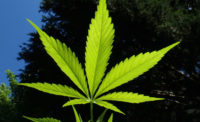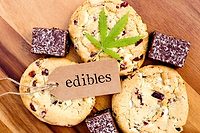Cannabis has been used as an oral medication since the Chinese treatise on pharmacology described that Emperor Shen Nung in 2737 BCE used it. In 1850, cannabis was listed in the U.S. Pharmacopoeia as a cure for many ailments; by the early 1900s, Squibb Company, Eli Lilly, and Parke-Davis manufactured drugs made from marijuana as antispasmodics, sedatives, and analgesics.
Fear of marijuana (cannabis) began in the 1920s and 1930s, as the number of Mexican immigrants increased and the Federal Bureau of Narcotics encouraged states to adopt the Marihuana Tax Act as a means to criminalize the production and use of cannabis.[1] It was passed in 1937, requiring the federal registration of cannabis dealers with taxation on sales along with penalizing users of cannabis with a fine and imprisonment.[2]
In the U.S. today, federal and state laws regarding the medical use of cannabis and cannabidiol (CBD) are in conflict due to the Controlled Substance Act (CSA) of the U.S. Drug Enforcement Agency (DEA), which has classified cannabis as a Schedule I drug “with no currently accepted medical use in treatment.”[3]
Although the U.S. has become more tolerant of cannabis use, it is barred from federal research, since it is a Schedule I drug with no medical value, even though a 2016 Gallop poll indicated that 89 percent of Americans think cannabis/marijuana should be allowed for medicinal use. Even the Mayo Clinic says marijuana has possible benefits for people with chronic pain, epilepsy, seizures, glaucoma, Crohn’s disease, and nausea due to chemotherapy.
In 1996, California passed Proposition 215, allowing individuals suffering from various chronic illnesses to use medical cannabis, which has now been legalized in 29 states and the District of Columbia. Legalization has produced some public health issues, especially in the edible cannabis market, including pediatric ingestion of these food products.
Hemp oil products containing the nonpsychoactive cannabinoid CBD or cannabidiol are available as capsules, chewable gummies, tinctures, and infused-edibles (brownies, cookies, lollipops, chocolate candy). CBD-infused edibles avoid the issues of marijuana odor and the stigma of use, because they are consumed like any other food—just in smaller portions or limited amounts. These CBD-containing, edible products are easy to transport. Some states have also allowed tetrahydrocannabinol (THC, the psychoactive cannabinoid in cannabis)-infused edibles, which can cause cognition, motor skill impairment, sedation, agitation, or anxiety when consumed beyond tolerance limits.
Colorado reported 1.96 million units of edible medical cannabis-infused products in 2014; within one year, the market had doubled—accounting for 45 percent of the total cannabis sales in the state.[4] Consumers already purchase more than $155 million of hemp-based foods and supplements yearly, so the edibles are an extension of that market.[5]
Cannabis edibles can be purchased over the internet, but there are currently no regulatory standards for these products—it’s truly a “buyer beware” market. The author purchased lollipops, gummies, chocolates, and Kush bars, requesting CBD products. The “high CBD” chocolates ($50 for four pieces) were labeled “0” on the wrapper. After contacting the supplier by email, she was told the product was “labeled incorrectly because they ran out of the usual wrappers.” Numerous inconsistencies in dosage for infused edibles (CBD and THC) were noted in purchases from internet sources.
The Colorado standard dose is 10 mg, but how is this determined when there are no regulatory standards or labeling requirements? Steep Hill Labs explained the difficulty in getting an accurate analysis of the dose at the Pittsburgh Cannabis Conference in 2017. First, extraction of the concentrate must be tested and assessed, with a loss of cannabinoids (30–60%) occurring during the extraction process. To identify the potency of the cannabis in the product, each batch of edibles must be tested before labeling to indicate the amount present in each brownie or chocolate. Since each test is costly, with only certified testing equipment used, who is verifying accuracy?
Inaccuracies in labeling and inconsistencies in formulation were reviewed in 2014 by investigative reporting by the Denver Post. They found that the actual THC content of retail edibles differed significantly from the amount claimed on the label.[6] As a result, Colorado instituted a requirement that THC concentration be assessed to insure that edibles do not contain more than 100 mg THC per serving.[4] But this was NOT a measure to insure label accuracy.
What about CBD concentration accuracy? Patients using medical cannabis products, whether CBD or CBD+THC, must be able to titrate their dosing regime. Vandrey et al.[7] reported that some CBD edible products contained only trace amounts or none at all.
Another consideration in the production of cannabis edibles is the appropriate testing for biocontaminants and pathogens. Infused edible products must indicate on the label that they have been tested for pesticides, heavy metals, mold, and residual solvents. No public safety guidelines or U.S. Food and Drug Administration label requirements exist, yet people with chronic medical conditions—cancer, Parkinson’s disease, ALS, Multiple sclerosis—want to use these products for pain and symptom management.
The nutritive value of cannabis—particularly its antioxidant benefits, which led to U.S. Patent 6630507B1 on October 7, 2003 for cannabis—is hardly ever acknowledged. The 1996 passage of California’s Proposition 215 legalized medical marijuana and opened the door for more people to benefit from its nutritional qualities, even though an exact nutritional profile of Cannabis sativa L. is lacking.
Dosing guidelines and quality standards for testing and labeling are essential to ensure the safe use of cannabis-infused edibles by all who want to benefit from this botanical that has been used around the world for thousands of years.
Betty Wedman-St Louis, Ph.D., is a licensed nutritionist.
References
1. Wedman-St Louis, B, ed. “Cannabis—A Clinician’s Guide.” In Legal Aspects of Cannabis (Boca Raton, FL: CRC Press, 2018).
2. Booth, M. Cannabis: A History (New York: St. Martin’s Press, 2003).
3. www.justice.gov/dea/pubs/csa/823.
4. Brohl, B, R Kammerzell, and WL Koski. Colorado Marijuana Enforcement Division: Annual Update (Denver: Colorado Department of Revenue, 2015).
5. www.votehemp.com.
6. Baca, R. 2014. “Tests Show THC Content in Marijuana Edibles Is Inconsistent.” The Denver Post, March 8.
7. Vandrey, R, et al. 2015. “Cannabinoid Dose and Label Accuracy in Edible Medical Products.” JAMA 313(24):2491–2493.
Food Safety and Cannabis Edibles




